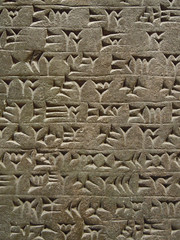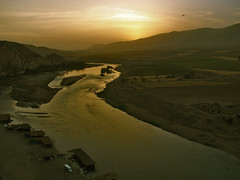From Hunting and Gathering to Civilizations, 2.5 million-1000 B.C.E.: Origins
Original from MrsBHatchTEACHER
| 7328873948 | hunting and gathering | Means of obtaining subsistence by humans before the mastery of sedentary agriculture; normally typical of tribal social organization |  | 0 |
| 7328873949 | civilization | Societies with reliance on sedentary agriculture, ability to produce food surpluses, and existence of nonfarming elites, along with merchant and manufacturing groups | 1 | |
| 7328873950 | neolithic | The New Stone Age between 8000 and 5000 B.C.E.; period in which adaptation of sedentary agriculture occurred; domestication of plants and animals accomplished |  | 2 |
| 7328873951 | nomadic societies | livestock hearding societies that do not have a permanent settlement. normally found on the fringes of civilized (urban) societies; commonly referred to as "barbarian" by civilized societies |  | 3 |
| 7328873952 | culture | Combination of ideas, objects, and patterns of behavior that result from human social interaction |  | 4 |
| 7328873953 | agrarian revolution | Occurred between 8000 and 5000 B.C.E.; transition from hunting and gathering to sedentary agriculture |  | 5 |
| 7328873954 | pastoralism | A nomadic agricultural lifestyle based on herding domesticated animals; tended to produce independent people capable of challenging sedentary agricultural societies |  | 6 |
| 7328873955 | Catal Huyuk | Early urban culture/civiization based on sedentary agriculture; located in modern southern Turkey; larger in population than Jericho, had greater degree of social stratification |  | 7 |
| 7328873956 | Bronze Age | From 4000 to 3000 B.C.E.; increased use of plow, metalworking; development of wheeled vehicles, writing |  | 8 |
| 7328873957 | Mesopotamia | Literally "between the rivers"; the civilization that arose in the alluvial plain of the Tigris-Euphrates river valleys |  | 9 |
| 7328873960 | cuneiform | A form of writing developed by the Sumerians using a wedge-shaped stylus and clay tablets |  | 10 |
| 7328873961 | city-state | A form of political organization typical of Mesopotamian civilization; consisted of agricultural hinterlands ruled by an urban-based king |  | 11 |
| 7328873962 | ziggurat | a massive tower building usually associated with Mesopotamian temple connections |  | 12 |
| 7328873963 | Babylonian Empire | Unified all of Mesopotamia circa 1800 B.C.E.; collapsed due to foreign invasion circa 1600 B.C.E. |  | 13 |
| 7328873964 | Hammurabi | The most important Babylonian ruler; responsible for codification of the law |  | 14 |
| 7328873965 | Pharaoh | The term used to denote the kings of ancient Egypt; the term, "great house" refers to the palace of the pharaohs |  | 15 |
| 7328873966 | pyramids | Monumental architecture typical of Old Kingdom Egypt; used as burial sites for pharaohs |  | 16 |
| 7328873967 | hieroglyphs | Form of writing developed in ancient Egypt; more pictorial than Mesopotamian cuneiform |  | 17 |
| 7328873968 | Kush | African state that developed along the upper reaches of the Nile circa 1000 B.C.E.; conquered Egypt and ruled it for several centuries | 18 | |
| 7328873969 | monotheism | The exclusive worship of one god; introduced by Jews into Middle Eastern civilization |  | 19 |
| 7328873970 | Phoenicians | Seafaring civilization located on the shores of the eastern Mediterranean; established colonies throughout the Mediterranean |  | 20 |
| 7328873971 | Harappa and Mohenjo Daro | Major urban complexes of Harappan civilization; laid out on planned grid pattern |  | 21 |
| 7328873972 | Aryans | Indo-European nomadic, warlike, pastorialists who replaced Harappan civilization |  | 22 |
| 7328873973 | Huanghe (Yellow) River Basin | Site of the development of sedentary agriculture in China |  | 23 |
| 7328873974 | Shang | 1st Chinese dynasty (after the legendary Xia) |  | 24 |
| 7328873976 | ideographic writing | Pictograph characters grouped together to create new concepts; typical of Chinese writing | 25 | |
| 7328873978 | Paleolithic | The period that ended about 3,000 years after the end of the last Ice Age, it lasted until about 10,000 years ago. (Old Stone Age) The period of the Stone Age associated with the evolution of humans. It predates the Neolithic period. |  | 26 |
| 7328873980 | eglitarian | equality among people (no social levels) | 27 | |
| 7328873981 | tools | Humans developed a wider range of ____ specially adapted to different environments from tropics to tundra | 28 | |
| 7328873982 | Neolithic Revolution | period of change from hunter-gatherer lifesyle to agricultural lifestyles associated with domestication, farming, and settlement |  | 29 |
| 7328873983 | patriarchy | father based/male dominated society |  | 30 |
| 7328873988 | record-keeping systems | ___ arose independently in all early civilization sand subsequently were diffused | 31 | |
| 7328873989 | Nile River | This river flooded regularly. |  | 32 |
| 7328873990 | Tigris River | This river's floods were unpredictable. |  | 33 |
| 7328873991 | Mesopotamian | Unpredictable weather patterns affected the development of the _____ civilization. | 34 | |
| 7328873992 | Egyptian | _______art demonstrated little change for nearly 1000 years. | 35 | |
| 7328873993 | Nubia and Kush | Kingdoms upriver from Egypt. | 36 | |
| 7328873996 | Jericho | One of the earliest cities: located in modern Israel. |  | 37 |
| 7328944470 | Hittites | a member of an ancient people who established a powerful empire in Asia Minor and Syria, dominant from about 1900 to 1200 b.c. | 38 | |
| 7328944471 | Vedic Religion | of or relating to the Aryans who settled in India c1500 b.c., or to their literature or religion. | 39 | |
| 7328948794 | Zoroastrianism | an Iranian religion, founded c600 b.c. by Zoroaster, the principal beliefs of which are in the existence of a supreme deity, Ahura Mazda, and in a cosmic struggle between a spirit of good, Spenta Mainyu, and a spirit of evil, Angra Mainyu. | 40 | |
| 7328951461 | Hebrew Monotheism | the doctrine or belief that there is only one God. | 41 | |
| 7328951462 | Rig Veda | one of the Vedas, a collection of 1028 hymns, dating from not later than the second millennium b.c. | 42 | |
| 7328953696 | Quipia | a device consisting of a cord with knotted strings of various colors attached, used by the ancient Peruvians for recording events, keeping accounts, etc. | 43 |

